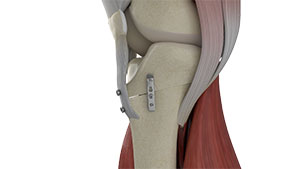Anterior Tibial Osteotomy
Dr. Garcia demonstrates his anterior tibial osteotomy technique
Anterior Tibial Osteotomy in Revision ACL Reconstruction: A Comprehensive Guide

Anterior Tibial Osteotomy (ATO) is an advanced surgical technique that has gained prominence in the field of orthopedic surgery, particularly for patients undergoing revision Anterior Cruciate Ligament (ACL) reconstruction with a high posterior tibial slope. This procedure is integral in reducing recurrent ACL tears and optimizing patient outcomes. This section delves into the background, indications, risks, complications, and outcomes associated with ATO in the context of ACL surgery.
Background
ACL injuries are among the most common ligament injuries in the knee, particularly in athletes. While primary ACL reconstruction has a high success rate, some patients experience recurrent instability and require revision surgery. One of the contributing factors to ACL graft failure is a high posterior tibial slope. The posterior tibial slope refers to the angle of the tibial plateau relative to a perpendicular line to the tibial shaft. A steep posterior slope increases the anterior shear forces on the knee, which can compromise the stability of the ACL graft.
Anterior Tibial Osteotomy is performed to reduce the posterior tibial slope, thereby decreasing the anterior shear forces and improving the biomechanical environment for the ACL graft. By modifying the tibial slope, ATO aims to provide a more stable foundation for the reconstructed ACL, reducing the risk of re-injury.
Indications
The primary indication for ATO in revision ACL reconstruction includes patients with a high posterior tibial slope, typically greater than 12 degrees, which predisposes them to recurrent ACL injuries. Specific scenarios where ATO is considered include:
- Failed Primary ACL Reconstruction: Patients who have experienced graft failure despite appropriate surgical technique and rehabilitation.
- High Posterior Tibial Slope: Measured radiographically, a slope exceeding the normal range is a critical factor.
- Recurrent Instability: Persistent knee instability following primary ACL reconstruction.
- Revision Surgery: In cases where revision ACL reconstruction alone may not address the underlying biomechanical issues.
Risks and Complications
As with any surgical procedure, ATO carries potential risks and complications. Understanding these is crucial for both the surgeon and the patient.
Risks:
- Infection: Post-operative infections, though relatively rare, can occur and require prompt management.
- Neurovascular Injury: There is a risk of injury to the nerves and blood vessels surrounding the knee.
- Delayed Union or Non-Union: The osteotomy site may heal slowly or not at all, necessitating further intervention.
- Hardware Complications: Screws and plates used to stabilize the osteotomy site can cause irritation or may need removal.
Complications:
- Knee Stiffness: Post-operative stiffness can limit range of motion and may require physical therapy or additional surgery.
- Malunion: Incorrect alignment of the osteotomy can result in suboptimal outcomes and may necessitate revision surgery.
- Pain: Chronic pain at the osteotomy site or due to hardware can occur.
- Thrombosis: Blood clots can form post-operatively, requiring prophylactic measures and management.
Outcomes
The success of ATO in revision ACL reconstruction is measured through various parameters, including knee stability, functional outcomes, and patient satisfaction. Research and clinical experience have demonstrated promising results in appropriately selected patients.
Knee Stability:
Reducing the posterior tibial slope through ATO significantly decreases the anterior shear forces on the knee. This biomechanical adjustment enhances the stability of the ACL graft, reducing the risk of further injury. Studies have shown that patients undergoing ATO in conjunction with ACL reconstruction exhibit improved knee stability compared to those who undergo ACL reconstruction alone.
Functional Outcomes:
Post-operative rehabilitation plays a crucial role in achieving optimal functional outcomes. Patients typically experience a significant improvement in knee function, allowing them to return to their desired activities, including sports. The success of ATO in restoring knee function is reflected in improved scores on standardized functional assessments such as the Lysholm Knee Scoring Scale and the International Knee Documentation Committee (IKDC) score.
Patient Satisfaction:
Patient satisfaction is a vital measure of the success of any surgical intervention. ATO has been associated with high levels of patient satisfaction due to the restoration of knee stability and function. Patients report a reduction in pain, improved quality of life, and a return to pre-injury activity levels. Regular follow-up and a comprehensive rehabilitation program are essential to maintain these positive outcomes.
Conclusion
Anterior Tibial Osteotomy is a valuable technique in the arsenal of an orthopedic surgeon, particularly for patients facing challenges in revision ACL reconstruction with a high posterior tibial slope. By addressing the underlying biomechanical factors contributing to ACL graft failure, ATO provides a stable environment for the reconstructed ligament, thereby reducing the risk of recurrent injuries and improving overall patient outcomes.
While the procedure carries inherent risks and potential complications, careful patient selection, meticulous surgical technique, and diligent post-operative care are key to maximizing the benefits of ATO. As advancements in surgical methods and rehabilitation protocols continue to evolve, the future of ATO in ACL reconstruction looks promising, offering hope for patients striving to regain their knee function and return to their active lifestyles.

















